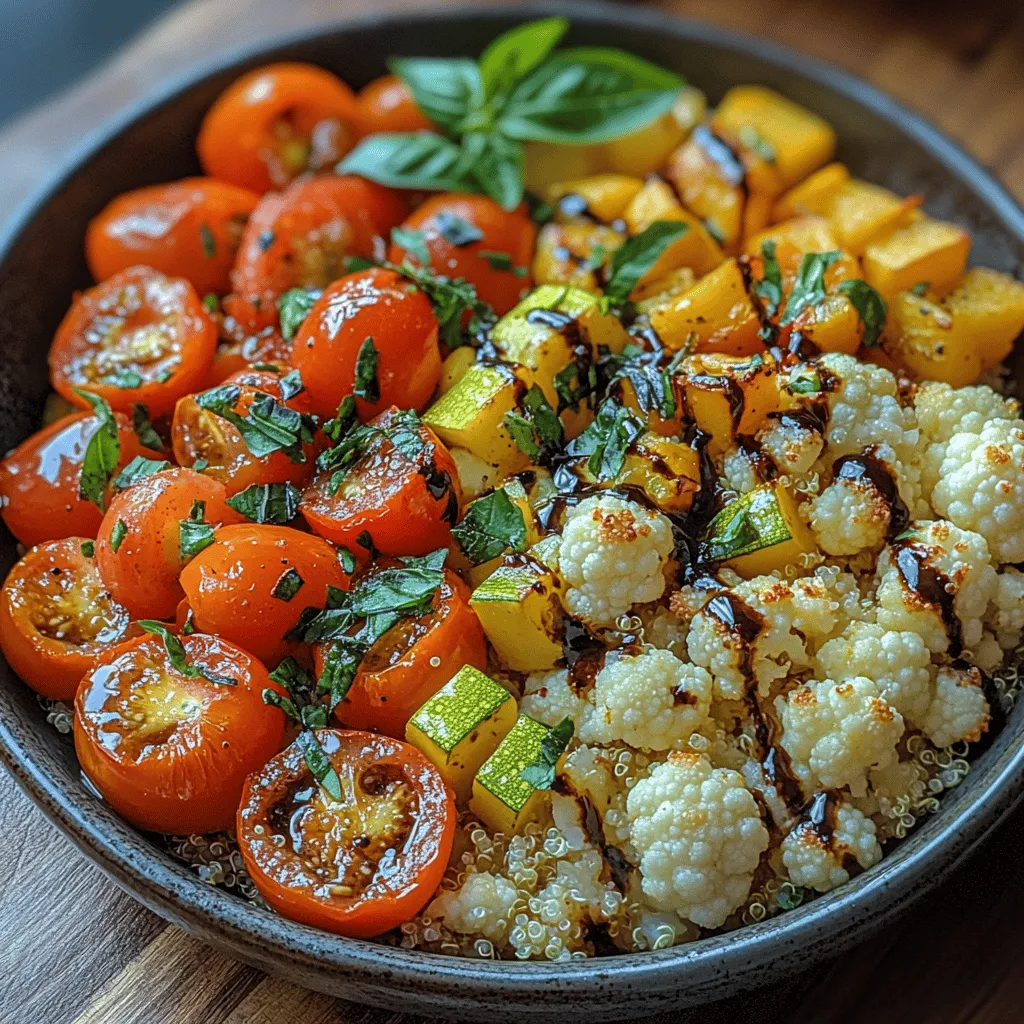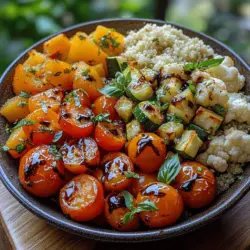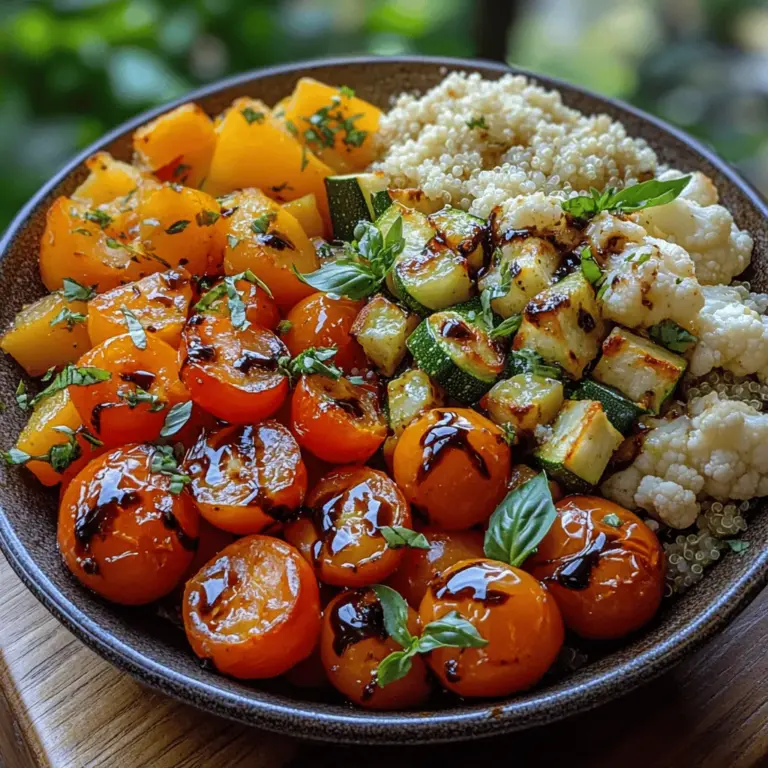Introduction
In recent years, the culinary landscape has seen a significant shift toward plant-based dishes, driven by an increasing awareness of health, sustainability, and ethical eating. As more individuals seek to incorporate nourishing ingredients into their diets, vibrant recipes like the Colorful Balsamic Roasted Veggie Bowl have gained popularity. This dish not only pleases the palate but also serves as a canvas for creativity in the kitchen. With its medley of colorful vegetables and a tangy balsamic dressing, this veggie bowl is a feast for both the eyes and the taste buds.
Roasted vegetables have long been cherished for their rich flavors and health benefits. When cooked properly, they develop a delightful caramelization that enhances their sweetness and depth. The Colorful Balsamic Roasted Veggie Bowl is an excellent way to showcase seasonal produce, providing a nutritious and satisfying meal that can be enjoyed at any time of the year. Whether you’re a dedicated vegan, a vegetarian, or simply looking to reduce your meat consumption, this recipe is adaptable to various dietary preferences and can easily be customized to meet individual tastes.
In addition to being visually appealing and delicious, this bowl brims with health benefits. Roasted vegetables are rich in vitamins, minerals, and dietary fiber, contributing to overall well-being. Incorporating a variety of colors in your meals not only makes for an enticing presentation but also ensures that you’re getting a wide range of nutrients. The Colorful Balsamic Roasted Veggie Bowl is a perfect dish to add to your weekly meal prep, as it can be enjoyed warm or cold, making it versatile for lunches, dinners, or even as a side dish during gatherings.
Understanding the Ingredients
Importance of Fresh Vegetables in the Recipe
At the heart of the Colorful Balsamic Roasted Veggie Bowl lies a selection of fresh vegetables that contribute to its vibrant appearance and delectable taste. Using seasonal produce ensures that you are getting the best flavor and nutritional value. The main vegetables featured in this recipe include cherry tomatoes, zucchini, yellow squash, bell peppers, red onion, and cauliflower. Each of these vegetables plays a unique role in the overall flavor profile and texture of the dish.
– Cherry Tomatoes: These bite-sized gems add a burst of sweetness and acidity, providing a refreshing contrast to the other roasted vegetables. They are also packed with antioxidants, particularly lycopene, which is known for its health-promoting properties.
– Zucchini and Yellow Squash: Both varieties of squash have a mild flavor and a tender texture that becomes beautifully soft when roasted. They absorb the flavors of the balsamic dressing, making them an excellent addition to the bowl.
– Bell Peppers: Adding a crunch and sweetness, bell peppers come in various colors, each contributing its unique flavor. They are rich in vitamins A and C, promoting a healthy immune system.
– Red Onion: This ingredient adds a sharp, savory note to the bowl. When roasted, red onions become caramelized and sweet, enhancing the overall depth of flavor.
– Cauliflower: Known for its versatility, cauliflower adds a hearty texture to the dish. It is low in calories and high in nutrients, including vitamin C and fiber, making it a fantastic choice for a filling meal.
The Significance of Balsamic Vinegar
Balsamic vinegar is the star of the dressing in this recipe, offering a rich, tangy flavor that elevates the taste of the roasted veggies. Its complex flavor profile, which includes sweet, sour, and slightly woody notes, complements the natural sweetness of the vegetables beautifully.
Beyond its delightful taste, balsamic vinegar also boasts several health benefits. It is low in calories and contains antioxidants that can help protect the body from oxidative stress. Additionally, balsamic vinegar has been shown to support cardiovascular health and may aid in digestion. By incorporating balsamic vinegar into your meals, you’re not only enhancing flavor but also boosting your nutritional intake.
The Role of Olive Oil and Sweeteners
Olive oil is the primary fat used in this recipe and is essential for roasting the vegetables. Known for its heart-healthy properties, olive oil is rich in monounsaturated fats and antioxidants, making it an ideal choice for cooking. It helps to enhance the flavors of the dish while also ensuring that the vegetables roast evenly and develop a beautiful golden color.
When it comes to sweetening the balsamic dressing, you have the option to use either honey or maple syrup. Both natural sweeteners add a touch of sweetness that balances the acidity of the balsamic vinegar. Honey, being a natural source of energy, contains vitamins and minerals, while maple syrup is rich in antioxidants and has a lower glycemic index, making it a suitable choice for those monitoring their sugar intake. Depending on your dietary preferences, you can choose the sweetener that best aligns with your needs.
Understanding Herbs and Seasonings
Herbs and seasonings play a crucial role in enhancing the overall flavor of the Colorful Balsamic Roasted Veggie Bowl. In this recipe, dried oregano and thyme are used to impart aromatic notes that complement the vegetables and balsamic dressing.
– Dried Oregano: This herb adds an earthy, slightly bitter flavor that works harmoniously with the roasted veggies. It is also known for its antibacterial and anti-inflammatory properties, making it a valuable addition to your diet.
– Thyme: Known for its woody, minty flavor, thyme brings a warm earthiness to the dish. It is rich in vitamins and has been traditionally used for its medicinal properties, including supporting respiratory health.
The importance of seasoning cannot be overstated; it is what transforms a simple dish into a memorable culinary experience. Properly seasoning your roasted vegetables with herbs, salt, and pepper ensures that each bite is bursting with flavor and leaves a lasting impression.
Step-by-Step Preparation Guide
Preheating the Oven: Setting the Stage for Perfect Roasting
To achieve perfectly roasted vegetables, it is essential to preheat your oven to the right temperature. A hotter oven promotes caramelization, resulting in crispy edges and tender interiors. For this recipe, set your oven to 425°F (220°C). This temperature strikes the perfect balance for roasting, allowing the vegetables to cook through while developing a golden, caramelized exterior.
Preparing the Vegetables: Tips for Properly Dicing and Mixing
Preparation is key to ensuring that your roasted veggies cook evenly and achieve the best texture. Begin by washing and drying all of your vegetables thoroughly. When chopping, aim for uniform pieces that are roughly the same size, as this allows for even cooking.
– Cherry Tomatoes: Leave them whole to retain their juices and burst of flavor during roasting.
– Zucchini and Yellow Squash: Slice these into half-moon shapes about ½ inch thick. This thickness allows them to soften without becoming mushy.
– Bell Peppers: Remove the seeds and core, then cut them into bite-sized pieces or strips, depending on your preference.
– Red Onion: Cut the onion into wedges to maintain its shape while roasting, allowing it to caramelize beautifully.
– Cauliflower: Cut the cauliflower into florets that are similar in size for even cooking.
Once your vegetables are chopped, place them in a large mixing bowl. The key to a visually appealing dish is to incorporate a variety of colors and textures, so feel free to adjust the quantities of each vegetable based on your personal preference or what you have on hand.
Crafting the Balsamic Dressing: Secrets to Flavor Balance
Now that your vegetables are prepped, it’s time to craft the balsamic dressing that will tie everything together. In a small bowl or jar, combine balsamic vinegar, olive oil, and your choice of sweetener (honey or maple syrup).
To achieve the perfect dressing consistency, start with a ratio of three parts olive oil to one part balsamic vinegar. This balance allows the richness of the olive oil to complement the acidity of the vinegar without overpowering it. Whisk or shake the mixture until well combined, and taste it to adjust the sweetness or acidity according to your preference. If you enjoy a more tangy flavor, feel free to add a bit more balsamic vinegar.
For added depth, consider mixing in the dried oregano and thyme into the dressing before drizzling it over the vegetables. This allows the herbs to infuse their flavors into the dressing, creating a cohesive taste that will elevate your roasted veggie bowl.
Roasting the Vegetables
With your oven preheated, vegetables chopped, and dressing ready, it’s time to roast! Spread the prepared veggies evenly on a baking sheet lined with parchment paper. This not only prevents sticking but also aids in achieving crispy edges. Drizzle the balsamic dressing over the vegetables, ensuring each piece is coated evenly. Toss the vegetables gently to distribute the dressing and seasonings.
Place the baking sheet in the preheated oven and roast for approximately 25-30 minutes, or until the vegetables are tender and caramelized. Halfway through the roasting process, stir the vegetables to promote even cooking and browning. The roasting process not only transforms the flavors of the vegetables but also enhances their nutritional profile by making certain nutrients more bioavailable.
As the vegetables roast, your kitchen will fill with enticing aromas, hinting at the delicious meal that’s about to come together.
Stay tuned for the next part of this recipe, where we will delve into the finishing touches and presentation of your Colorful Balsamic Roasted Veggie Bowl, ensuring it looks as good as it tastes!

Importance of Spacing Vegetables on the Baking Sheet for Even Roasting
When preparing your Colorful Balsamic Roasted Veggie Bowl, one crucial aspect to achieve perfectly roasted vegetables is the proper spacing on the baking sheet. Crowding the vegetables can lead to steaming rather than roasting, which prevents that desirable caramelization and unique flavor development. To ensure even roasting, spread the vegetables in a single, even layer on the baking sheet, giving them ample space to breathe.
Using a large baking sheet can help accommodate all your veggies without overcrowding. If you’re roasting a large batch, consider using two sheets. This method not only ensures that each piece of vegetable gets its fair share of heat but also promotes an appealing texture—crispy on the outside and tender on the inside.
Monitoring Cooking Time and Techniques
Monitoring the cooking time is essential for achieving the perfect roast. Generally, most vegetables will take anywhere from 20 to 30 minutes at 425°F (220°C). However, the precise time may vary based on the type and size of the vegetables. It’s beneficial to set a timer and start checking for doneness around the 15-minute mark.
Best Practices for Checking the Doneness of Roasted Veggies
To check if your vegetables are done, look for indicators such as a golden-brown color and fork-tender texture. You can use a fork or knife to pierce the vegetables; they should be easily penetrable but not mushy. If you find that some veggies are cooking faster than others, remove them from the baking sheet and continue roasting the remaining ones. This practice helps create a perfectly roasted mix.
Tips for Stirring and Flipping to Avoid Uneven Cooking
Stirring and flipping your vegetables halfway through the roasting process ensures that they cook evenly. Use a sturdy spatula to gently turn the veggies, allowing all sides to come into contact with the hot baking sheet. Avoid excessive flipping, as this may break the vegetables apart, particularly those that are more delicate.
Assembling the Bowl
Once your vegetables are roasted to perfection, it’s time to assemble the bowl, which is as much about flavor as it is about aesthetics.
Creating a Base with Quinoa or Brown Rice
For a hearty and nutritious base, consider using either quinoa or brown rice. Both options provide a great foundation for your veggie bowl, but they offer different nutritional benefits.
– Nutritional Comparison of Quinoa and Brown Rice: Quinoa is a complete protein, containing all nine essential amino acids, making it an excellent choice for plant-based diets. It also has a lower glycemic index compared to brown rice, which can be beneficial for blood sugar management. On the other hand, brown rice is rich in fiber and provides a good source of energy due to its higher carbohydrate content.
– How to Prepare These Grains for the Bowl: To prepare quinoa, rinse it under cold water before cooking to remove its natural coating, called saponin, which can impart a bitter taste. Cook it in a 2:1 ratio of water to quinoa, bringing it to a boil before simmering for about 15 minutes or until the water is absorbed. For brown rice, use a similar method, but note that it typically requires a longer cooking time of about 45 minutes.
Layering the Ingredients for a Stunning Presentation
Once your base is ready, it’s time to layer the ingredients. Start with a generous scoop of quinoa or brown rice, then artfully arrange your roasted vegetables on top.
– Tips for Arranging Roasted Veggies for Visual Appeal: Use an assortment of colors and shapes to create a vibrant dish. For instance, place bright red bell peppers next to deep purple eggplants and green zucchini. This colorful contrast not only makes the dish visually appealing but also indicates a variety of nutrients.
– Importance of Garnishing with Fresh Herbs for Added Flavor and Beauty: Don’t skip the garnish! Fresh herbs such as parsley, cilantro, or basil can elevate your dish both in flavor and appearance. A sprinkle of herbs not only adds freshness but also enhances the overall taste profile of the bowl.
Health Benefits of the Colorful Balsamic Roasted Veggie Bowl
The Colorful Balsamic Roasted Veggie Bowl is not just a feast for the eyes; it is also packed with health benefits.
Nutritional Profile Breakdown
This dish is rich in vitamins, minerals, and antioxidants thanks to its diverse vegetable content. Each vegetable contributes unique nutrients. For instance, bell peppers are high in vitamin C, while carrots are packed with beta-carotene.
– Caloric Content and Macro-Nutrient Analysis of the Dish: A serving of this veggie bowl typically contains around 350-450 calories, depending on the portion size and the base chosen (quinoa or brown rice). The macro-nutrient distribution generally includes approximately 10-15 grams of protein, 60-80 grams of carbohydrates, and 5-15 grams of healthy fats (especially if you add a dressing or nuts).
Health Benefits Associated with Consuming a Variety of Vegetables
Eating a broad spectrum of vegetables can lead to numerous health benefits, including improved digestion, reduced risk of chronic diseases, and better heart health. The fiber content from the vegetables and grains helps maintain a healthy gut, while the antioxidants combat oxidative stress in the body.
The Role of Plant-Based Meals in a Balanced Diet
Incorporating plant-based meals like the Colorful Balsamic Roasted Veggie Bowl into your diet is essential for overall health. Recent studies show that plant-based diets can lead to lower rates of obesity, heart disease, and diabetes.
– Statistics on Plant-Based Diets and Their Environmental Impact: Transitioning to a plant-based diet can also have a positive impact on the environment. According to the Food and Agriculture Organization (FAO), reducing meat consumption can lead to a significant decrease in greenhouse gas emissions, making plant-based meals a sustainable choice for a healthier planet.
Variations and Customization Options
One of the best features of the Colorful Balsamic Roasted Veggie Bowl is its versatility. You can easily customize the recipe to suit your tastes and dietary needs.
Creative Additions to the Veggie Bowl
– Suggestions for Additional Vegetables and Proteins to Include: Feel free to add seasonal vegetables such as asparagus, Brussels sprouts, or sweet potatoes. For an added protein boost, consider including chickpeas, black beans, or tofu.
– Ideas for Different Dressings or Sauces to Enhance Flavor: While the balsamic glaze adds a wonderful tangy sweetness, you can experiment with other dressings. A tahini drizzle, avocado lime dressing, or a spicy sriracha sauce can completely transform the flavor profile of the bowl.
Adapting the Recipe for Dietary Restrictions
This recipe can easily be modified to accommodate various dietary restrictions.
– Gluten-Free, Vegan, and Low-Carb Adaptations of the Dish: Quinoa is naturally gluten-free, and the entire dish is vegan as long as you avoid adding dairy-based ingredients. For a low-carb alternative, consider using cauliflower rice instead of quinoa or brown rice, which can provide a similar texture with fewer carbs.
Pairing Suggestions
To enhance your Colorful Balsamic Roasted Veggie Bowl, consider some complementary side dishes and beverages.
Complementary Side Dishes and Beverages
– Recommended Sides that Go Well with the Veggie Bowl: Pair your bowl with a light side salad or some roasted garlic bread for a complete meal. A simple arugula salad drizzled with lemon vinaigrette can add a refreshing counterpart to the richness of the roasted veggies.
– Beverage Pairings That Enhance the Meal Experience: A crisp white wine, such as Sauvignon Blanc, or a refreshing herbal iced tea can pair beautifully with the flavors of the bowl. For non-alcoholic options, consider a sparkling water with a splash of lemon or lime.
Conclusion
The Colorful Balsamic Roasted Veggie Bowl is a delightful dish that not only nourishes the body but also pleases the palate and the eyes. With its vibrant mix of vegetables, nutritious grains, and bold flavors, it’s a perfect representation of how enjoyable healthy eating can be.
Embrace the versatility of this recipe by experimenting with different vegetables, grains, and dressings. Each time you prepare it, you’ll discover new flavors and combinations that keep your meals exciting.
Ultimately, cooking with fresh, seasonal ingredients fosters a deeper connection to the food we eat and the environment around us. So gather your ingredients, enjoy the cooking process, and savor the satisfaction of a homemade meal that contributes positively to your health and the planet.

